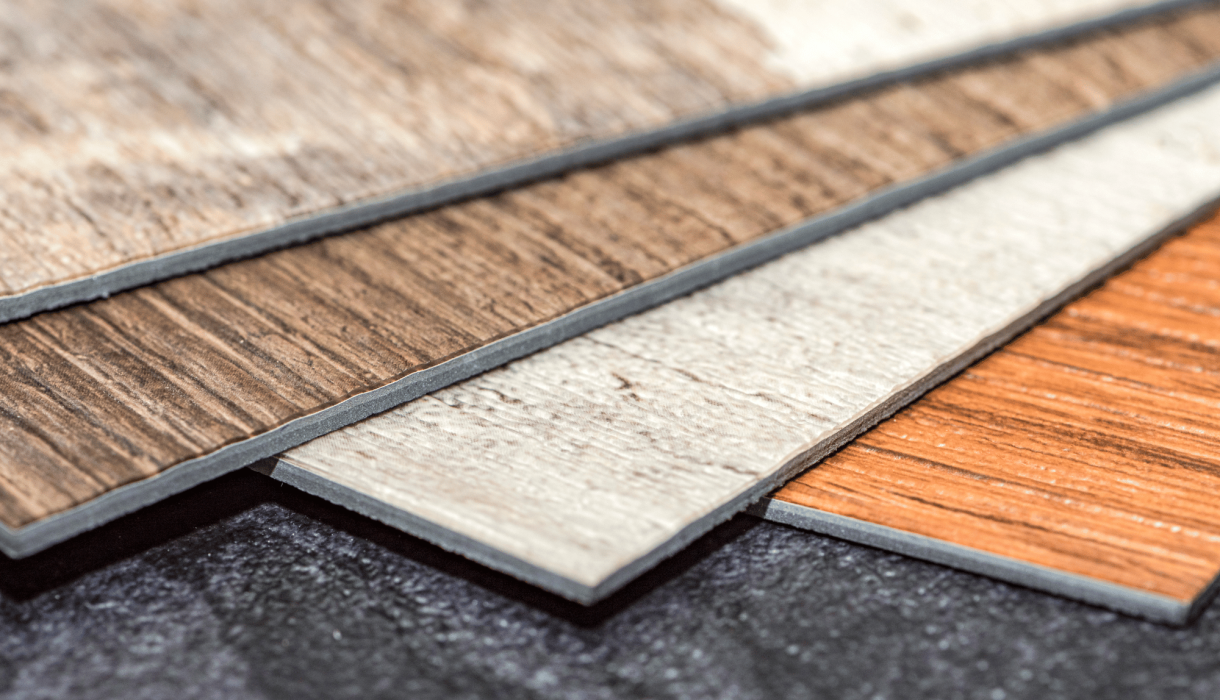Vinyl flooring stands out as one of the most practical and adaptable flooring choices for homes across Wigan and the North West. At Abernethy Bespoke Flooring, we’ve mastered the art of vinyl floor installation through years of hands-on experience. While many homeowners wonder about fitting vinyl flooring themselves, our professional approach ensures lasting results that stand the test of time. Let’s walk through how we tackle vinyl floor fitting from start to finish.
Getting the Groundwork Right
The secret to a perfect vinyl floor lies mostly in what happens before the first piece goes down. Preparation makes all the difference between an amateur-looking job and professional craftsmanship.
Measuring With Precision
When our team begins a vinyl installation, accurate measurements come first. We never rely on a single measurement – instead, we check and double-check dimensions to avoid costly mistakes.
“I’ve seen too many DIY projects go wrong because someone missed a few centimetres here or there,” says Michael Abernethy, founder of ABF. “We take the time to measure correctly, and it pays off in the finished result.”
Beyond simple length and width, we account for all the room’s unique features. Fireplace hearths, awkward corners, doorways, and fitted units all need careful consideration. We create detailed sketches of challenging rooms, breaking complex spaces into manageable sections for accurate material calculation.
We also factor in a waste allowance of about 10% for straight installations and up to 15% for herringbone flooring, which requires more intricate cutting.
Preparing Different Subfloors
The quality of what lies beneath your vinyl flooring directly impacts how your new floor looks and performs over time. Each subfloor type presents unique challenges:
Wooden Floorboards
Old wooden floorboards rarely provide an ideal base for vinyl flooring. Even newer boards can have slight gaps that might telegraph through thin vinyl. Our approach includes:
- Checking for loose or squeaky boards and fixing them with appropriate screws
- Filling visible gaps between boards with suitable wood filler
- Sanding down any raised edges or high spots
- Installing a plywood overlay to create a perfectly smooth, stable surface
The plywood layer serves as a critical foundation for vinyl. We use moisture-resistant ply at an appropriate thickness (typically 6mm) and secure it properly with screws placed at 15cm intervals.
Concrete Floors
Concrete subfloors require different preparation techniques:
- Testing moisture levels with professional equipment
- Filling cracks and holes with specialist compounds
- Grinding down any high spots for a perfectly level finish
- Applying self-levelling compound where needed
On new concrete, we ensure the floor has fully cured before installation begins – rushing this stage can lead to moisture problems later.
Existing Tiles
While it’s possible to install vinyl over existing tiles, we approach this with caution. We carefully check for loose tiles and ensure grout lines won’t show through the new vinyl. For deeper grout lines, we apply levelling compound to create a smooth surface before installation.
Professional Installation Techniques
With preparation complete, we move to the installation phase, where technique and attention to detail make all the difference.
Acclimatisation Matters
Quality vinyl flooring needs time to adjust to your home’s temperature and humidity. We always allow materials to sit in the installation space for at least 24 hours before fitting begins. This simple step prevents problems with expansion or contraction after installation.
Starting in the Right Place
Where you begin laying vinyl can significantly impact the final look. For most rooms, we start along the wall most visible when entering the space. However, this varies based on room layout and features.
For vinyl planks, we often begin in the centre of the room and work outward to ensure even distribution of cut pieces at the edges. This creates a more balanced, professional appearance.
Expert Cutting Techniques
Precise cutting separates professional installation from DIY attempts. We use different cutting methods depending on the type of vinyl:
For sheet vinyl, we use sharp utility knives with fresh blades and use straightedges for perfectly straight cuts. When fitting around complex shapes like door frames or pipes, we create paper templates first to eliminate costly errors.
For LVT floor fitting, we use specialised cutting tools that allow for perfect straight cuts and curved sections. Each piece is measured individually before cutting to account for slight variations in room dimensions.
Managing Temperature Effects
Vinyl expands and contracts with temperature changes. We leave an expansion gap of about 5mm around the room’s perimeter, hidden later by skirting boards or beading. This small detail prevents buckling or lifting when temperatures rise in summer months.
Room-Specific Installation Approaches
Different rooms present unique challenges for vinyl installation. Here’s how we adapt our methods:
Bathroom Vinyl Installation
Bathrooms demand special attention due to their high moisture levels and fitted elements like toilets and bathtubs. Our approach includes:
Sealing the entire subfloor with appropriate moisture barriers to prevent water damage from below. For wooden subfloors, we use marine-grade plywood as a base layer for added protection.
When fitting around toilets, we either temporarily remove the toilet or use careful templating techniques to achieve a perfect fit. We never cut corners by trying to slide vinyl underneath – this approach inevitably leads to poor finishing and potential water ingress.
For bathtubs and shower trays, we ensure the vinyl extends slightly up the wall behind these fixtures, creating a watertight seal that prevents water from getting under the flooring.
All seams in bathroom installations receive waterproof sealing to prevent moisture penetration. This small detail greatly extends the life of bathroom vinyl floors.
Kitchen Installation Excellence
Kitchen floors face heavy traffic, potential water spills, and the challenge of fitting around cabinets and appliances. Our kitchen vinyl installations focus on:
Careful planning of sheet layouts to minimise seams in high-risk areas near sinks and dishwashers. When seams are unavoidable, we heat-weld them for maximum water resistance.
For kitchen islands and fitted units, we have two approaches depending on the situation. If units are already installed, we cut the vinyl precisely to fit around them. For new kitchen installations, we sometimes install vinyl underneath units for a more seamless look.
We pay special attention to refrigerator and stove areas, knowing these heavy appliances can damage poorly installed flooring. Extra reinforcement and careful fitting ensure the vinyl withstands the weight and movement of these appliances.
Handling Special Challenges
Every home presents unique installation challenges. Here’s how we handle some common situations:
Pattern Matching For Sheet Vinyl
When working with patterned sheet vinyl, careful pattern alignment makes the difference between an amateur and professional installation. We take time to plan the layout so patterns flow naturally across the room without obvious mismatches at seams.
Tackling Doorways and Transitions
Doorways deserve special attention during vinyl installation. We carefully plan how the vinyl meets other flooring types, using appropriate transition strips where needed. For same-level transitions, we heat-weld seams for an almost invisible join between rooms.
When fitting under door frames, we undercut the frames rather than cutting the vinyl around them. This approach creates a much cleaner finish and prevents edges from lifting over time.
Working With Complex Room Shapes
L-shaped rooms or spaces with alcoves require thoughtful planning. We aim to minimise visible seams by using larger sheets where possible. When seams are necessary, we position them in less noticeable areas and ensure perfect alignment.
Going Beyond Basic Installation
Our floor preparation services extend beyond simple installation to address fundamental issues that might affect your new vinyl floor.
Levelling Uneven Floors
Uneven floors create both aesthetic and practical problems for vinyl flooring. Our levelling techniques include:
Self-levelling compounds for minor variations, applied with expert precision to create perfectly flat surfaces. For more significant issues, we use floor screeding to correct substantial slopes or dips before vinyl installation.
We pay particular attention to thresholds between rooms, ensuring smooth transitions without trip hazards or visible bumps under the vinyl.
Moisture Barrier Application
Moisture represents one of the biggest threats to vinyl flooring, particularly on ground floors or in properties with known damp issues. We apply professional-grade damp-proof membranes where needed to prevent moisture migration through concrete floors.
For suspended timber floors, we ensure adequate ventilation below while sealing the surface appropriately. This balanced approach prevents both condensation issues and moisture penetration.
After We’ve Gone: Maintenance Tips
Once we’ve completed your vinyl floor installation, we provide guidance on keeping it looking its best:
- Wait at least 24 hours before moving furniture back onto new vinyl flooring
- Use protective pads under furniture legs to prevent dents and scratches
- Clean with pH-neutral cleaners specifically formulated for vinyl floors
- Avoid harsh chemicals or abrasive cleaning tools that might damage the surface
- Place mats at exterior doors to reduce dirt and grit being tracked onto your new floor
Why Professional Installation Makes Financial Sense
DIY vinyl installation might seem tempting, but professional fitting often proves more economical in the long run. Common DIY pitfalls include:
Inadequate subfloor preparation leading to bumps, dips or visible patterns showing through the vinyl. These issues typically can’t be fixed without complete reinstallation.
Improper cutting resulting in gaps at edges or wastage of expensive materials. Our professional techniques minimise waste while achieving precise fits.
Poor seam management creating weak points where water can penetrate or edges can lift. Professional heat-welding and sealing techniques create stronger, more durable floors.
Incorrect adhesive application causing bubbling, lifting or premature failure. We select and apply the right adhesives for each specific situation.
Ready For Your Vinyl Floor Installation?
At Abernethy Bespoke Flooring, we bring skill, experience and attention to detail to every vinyl flooring project. From meticulous preparation to flawless finishing, our professional approach ensures results that stand the test of time.
Whether you’re considering vinyl for your kitchen, bathroom, or throughout your home, our team delivers exceptional quality and value. We’ve been transforming spaces throughout Wigan and the North West with our expert flooring services.
Ready to discuss your vinyl flooring project? Contact us at 07495 424721 or email michaelabernethy@live.co.uk for a free consultation. Our friendly team will guide you through options, offer honest advice, and provide a detailed quotation with no hidden costs.


